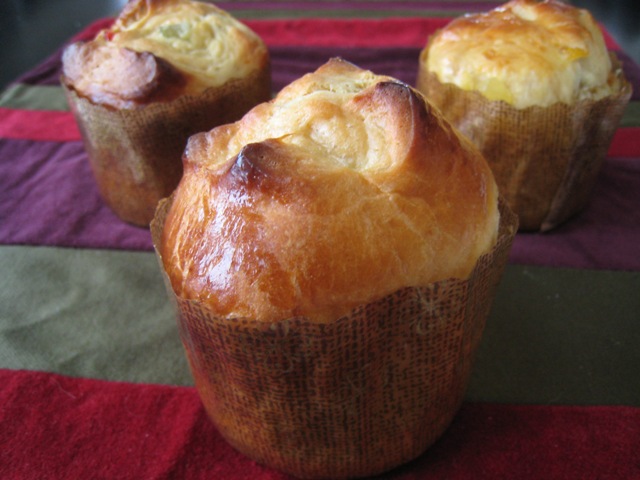PANETTONE
This year I decided to make Panettone. For those of you who might not know what it is, it is an Italian bread, typical of Milan. It has a cupola shape on top of a cylidrical base. The traditional way to make it is a long process which involves the curing of the dough, which is acidic, similar to sourdough. The proofing process alone takes several days, giving the cake its distinctive fluffy characteristics. It contains candied orange, citron and lemon zest, as well as raisins. It is served in slices, vertically cut, accompanied with sweet hot beverages or a sweet wine.
Okay, first, the version that I made did not take several days. It took one day. I have never eaten Panettone fresh from a bakery, but from the large red boxes containing a nice big Panettone you can buy in the grocery store at Christmas time. My Panettone turned out as good, if not better, than that I’ve had before. You could taste the orange and lemon zest in the batter, and it was nicely sweet and rich. It should be rich-it contains 4 eggs, 3 additional egg yolks, and 1 1/2 sticks butter. I had ordered miniature Panettone paper molds from King Arthur, so mine were a little smaller than the recipe called for. I made 12 of them, and 2 miniature loaf pans. When they were finished cooking last night, I was too tired to stay up to wait for them to cool before wrapping them. So they sat out, uncovered, all night, and I did find that today they were drier than when I tasted them last night. But that’s okay, because leftovers can be toasted, turned into French toast, or made into a bread pudding.
MINIATURE PANETTONE
From the Martha Stewart Living Christmas Cookbook
Makes 1 dozen
For Martha’s recipe, they baked them in half-pound brown paper bags (3 x 4 ¾ inches).
For Sponge:
1/3 cup warm water
1 envelope active dry yeast
½ cup all-purpose flour
For Bread Dough:
½ cup warm milk
1 envelope active dry yeast
2/3 cup sugar
4 large whole eggs
3 large egg yolks
1 teaspoon pure vanilla extract
¾ cup (1 ½ sticks) chilled unsalted butter, plus more, melted, for bowl, plastic wrap, and bags
3 ½ cups all-purpose flour, plus more for work surface
2 cups mixed dried and candied fruit, such as currants, orange peel, apricots, and cherries, finely chopped
Grated zest of 1 orange
Grated zest of 1 lemon
1 tablespoon heavy cream
Confectioner’s sugar, for dusting
1. Make sponge: Pour the warm water into a small bowl, and sprinkle with yeast. Stir with a fork until yeast has dissolved. Let stand until foamy, 5-10 minutes. Stir in flour, and cover bowl with plastic wrap. Let rise in a warm place until doubled in bulk, about 30 minutes.
2. Make the dough: Pour warm milk into a small bowl, and sprinkle with yeast. Stir to dissolve, and let stand until foamy, 5-10 minutes. In a medium bowl, whisk together sugar, eggs, 2 egg yolks, and vanilla. Whisk milk mixture into egg mixture.
3. In the bowl of an electric mixer, beat butter and flour on medium speed until mixture is crumbly. With mixer on low speed, slowly add egg mixture; continue beating on medium speed until smooth.
4. Add sponge mixture; beat on high speed until dough is elastic and long strands form when dough is stretched, about 5 minutes. Beat in dried fruit and grated zests. Transfer dough to a buttered bowl, and cover with a piece of buttered plastic wrap. Let rise in a warm place until doubled in bulk, about 2 hours.
5. Fold 12 paper bags down to make cuffs, about 3” deep. Generously butter the bags inside and out; set aside. Turn out dough onto a lightly floured surface; knead a few times, turning each time, until smooth. Divide the dough into 12 equal parts, and knead into balls. Drop balls into prepared bags. Place bags on a large rimmed baking sheet; cover loosely with buttered plastic. Let rise in a warm place until dough reaches just below the tops of the bags, 45 to 60 minutes.
6. Preheat oven to 400 degrees F, with rack in lower third. In a small bowl whisk together remaining egg yolk and the cream. Brush tops of dough with egg mixture. Using kitchen scizzors, cut an X, centered, in the top of each loaf. Bake 10 minutes. Reduce oven temperature to 375 degrees F and continue baking until loaves are deep golden brown, about 20 minutes, rotating baking sheet halfway through. If they start to get too brown, drape a piece of aluminum foil over tops. Transfer baking sheet to a wire rack; let panettone cool completely; dust with confectioners’ sugar.



I have always wanted to do this. I made a traditional family sweet instead this year, and bought a panettone, but I bet the scent in your kitchen was to die for! They look beautiful! Maybe next year.
Palma-I saw your post on the sweet you made this year. That looked like a lot of work! I trhink you’d like making the Panettone. It was easy to make, and the dough was really nice to work with. Have a Merry Christmas!
Your job, is to remind me about Thanksgiving 2010 that I want to make these for Christmas 2010 :D!
Kim-I’ll put it on my calendar to remind you next year!
They look wonderful! Remind me too, would you?
Nancy-I’ll sure do my best.
These are so cool! I have always wondered how they are made.
Girasoli-Thanks. Tonight I made bread pudding with the leftovers and it was fantastic.
Oh, those look wonderful. Nice job!